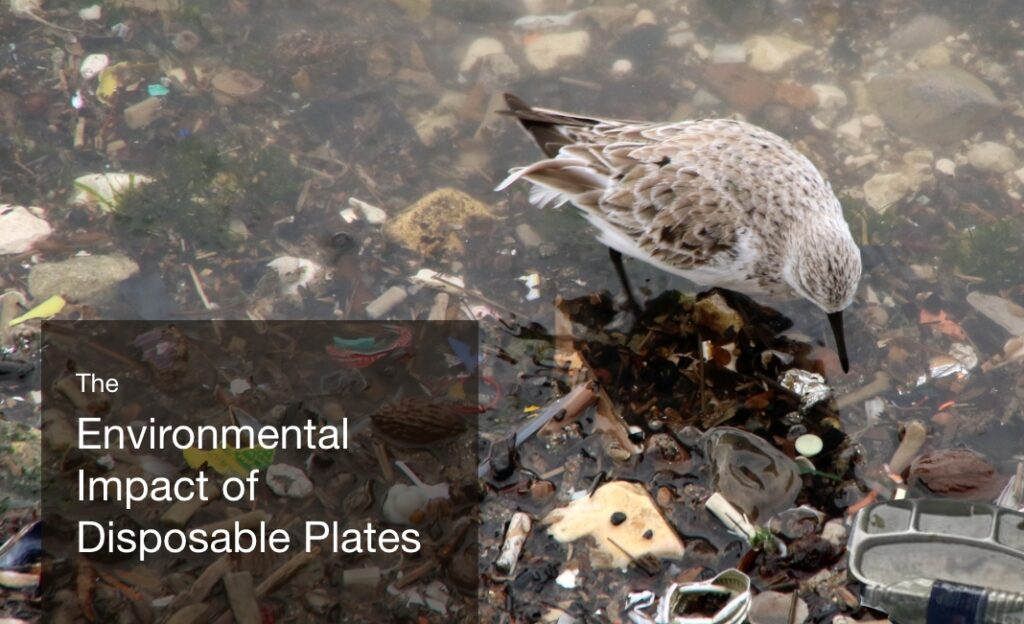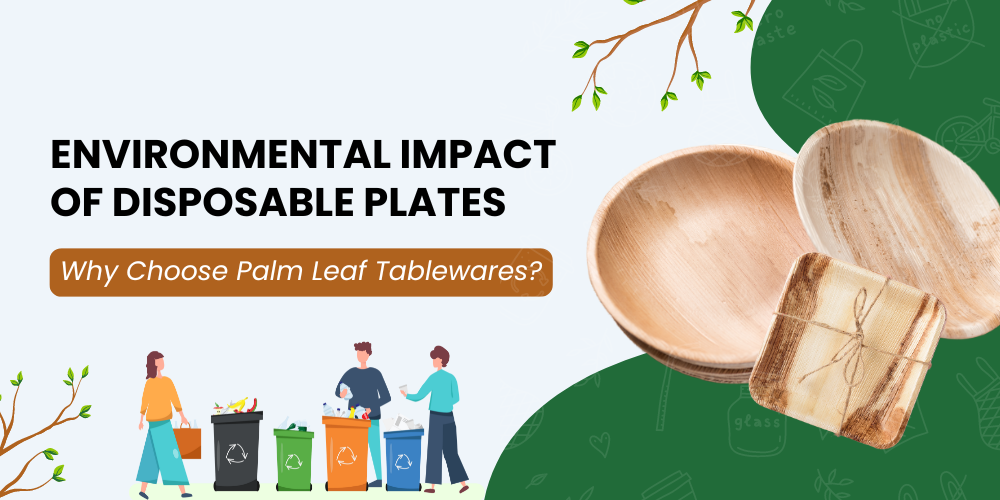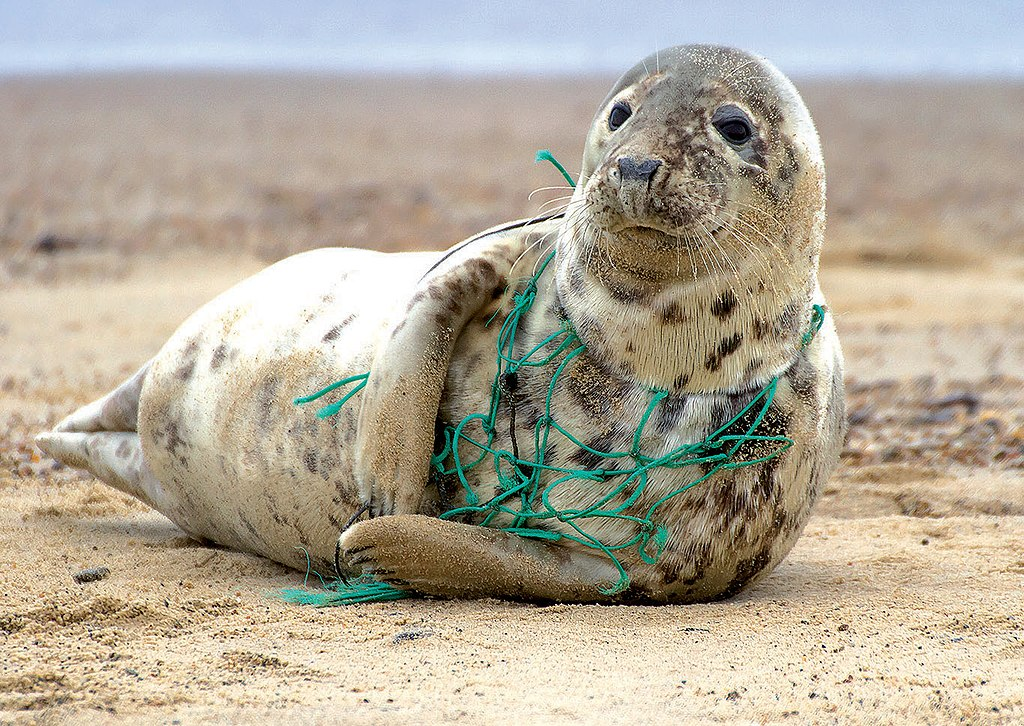Imagine a curious toddler playing at the beach, joyfully exploring the world around them. Suddenly, they pick up a brightly colored piece of plastic, thinking it’s a toy or even something to eat. As parents rush to intervene, the reality of our disposable culture hits hard. Just like this toddler, countless animals mistake plastic for food, leading to harmful consequences.
But there are better products that naturally decompose and return to the earth, helping protect both our children’s future and the planet. By making this simple switch, we can reduce the environmental impact of our daily choices and create a safer, cleaner world for generations to come.

The Environmental Impact of Disposable Tablewares and the Eco-Friendly Options
The problem with traditional disposable plates is rooted not only in modern environmental concerns but also in historical shifts in culture, technology, and consumption habits.
The concept of disposable tableware is not new. Its origins can be traced back to the late 19th century when the first paper plates were introduced as a convenient alternative to traditional dishware. However, it wasn’t until the mid-20th century, with the rise of consumer culture and the convenience movement, that disposable plates gained widespread popularity. This wave was fueled by the post-World War II economic boom, which saw an increase in disposable products designed to save time and effort in food preparation and cleanup.
Initially, disposable plates were made from paper, which seemed like a practical solution. However, the environmental implications of this convenience began to surface as the demand for single-use items skyrocketed. The introduction of plastic plates in the 1950s marked a significant turning point, providing a cheaper, more durable option that quickly became the norm for parties, picnics, and fast-food establishments.
The Environmental Consequences
Styrofoam Plates
A type of polystyrene, Styrofoam plates are lightweight and resistant to moisture but take hundreds of years to decompose and are not recyclable in most areas. They also release toxic chemicals when broken down or incinerated.
Plastic Plates
Plastic plates, made from polystyrene and polypropylene, are particularly problematic. Their production process is resource-intensive, requiring fossil fuels and generating substantial greenhouse gas emissions. Once used, these plates can take hundreds of years to decompose, contributing to the growing crisis of plastic pollution.
- Landfill Overflow: Once discarded, plastic plates can take hundreds of years to decompose. This long lifespan leads to overflowing landfills, where plastics leach harmful chemicals into the soil and groundwater
- Wildlife Impact: Animals often mistake plastic items for food, leading to ingestion that can cause choking, intestinal blockages, and starvation. Additionally, plastic debris can entangle animals, leading to injuries and death
- Ocean Pollution: A significant portion of disposable plastic ends up in oceans, posing a severe threat to marine life. Animals often mistake plastic for food, leading to ingestion which can cause choking, starvation, and death
Bamboo Plates
Bamboo plates are biodegradable and compostable. Bamboo grows quickly and requires less water and pesticides than traditional crops. However, the processing of bamboo into plates can involve energy and resources, and the transportation of these plates might offset some environmental benefits.
Paper Plates
Martin Keyes of Lempster, New Hampshire, invented the paper plate in 1903 and introduced it to the market a year later as the first product of the Keyes Fibre Company.
While paper plates are often marketed as a more environmentally friendly option, they come with challenges. The production of paper plates requires cutting down trees, which contributes to deforestation and habitat loss.
- Chemical Usage: The manufacturing process involves chemicals for bleaching and processing, which can pollute waterways and harm ecosystems
- Waste Management Issues: Although paper plates are biodegradable, they still contribute to waste accumulation. Many paper plates are coated with plastic or other materials that hinder their ability to decompose effectively
Biodegradability Issues: Although paper plates are biodegradable, many are coated with plastic or other materials that hinder their decomposition, leading to waste accumulation
Shift Towards Sustainability
As people have become more aware of environmental issues, there has been a growing trend toward sustainability. In the late 20th and early 21st centuries, more consumers started looking for eco-friendly alternatives to traditional disposable plates. This change is motivated by a desire to reduce waste and lessen the impact on the environment.
The Emergence of Eco-Friendly Alternatives
In response to the problems associated with traditional disposable plates, innovative alternatives have emerged. One of the most promising options is palm leaf plates, made from naturally fallen areca palm leaves.
- Sustainability: Palm leaf plates are a renewable resource, as they utilize leaves that would otherwise decompose naturally
- Biodegradable and Compostable: Unlike plastic and many paper plates, palm leaf plates decompose within weeks, returning nutrients to the soil and minimizing waste
Chemical-Free: These plates are free from harmful chemicals, making them a safer option for food service
Why Choose Palm Leaf Tablewares?
Palm leaf plates are crafted from the naturally fallen leaves of the areca palm tree, commonly found in South Asia. The production process involves collecting the leaves, cleaning them thoroughly, and then heat-pressing them into various shapes and sizes. This process requires no additional chemicals or coatings, making the plates safe for food use and environmentally friendly.
Benefits of Palm Leaf Plates
- Break Down Naturally: Palm leaf plates break down naturally within 45 to 60 days
- Eco-Friendly Source: Made from naturally fallen palm leaves, so no trees are cut down
- Strong and Heat-Resistant: They hold up well under hot and oily foods
- No Harmful Chemicals: Made without synthetic chemicals or dyes
- Looks Nice: Each plate has a unique and natural appearance
- Low Energy Use: Producing them uses less energy compared to plastic or Styrofoam plates
- Flexible Use: Good for various types of food and occasions
- Easy to Dispose Of: These can be composted or recycled, making them better for the environment
Wind and Storm Resilience
In outdoor settings, palm leaf plates are great for windy conditions. Their weight and strength keep them from being easily blown away, making them a good choice for outdoor gatherings. However, they can handle only moderate winds, so in extreme weather like storms, it’s best to secure them to avoid damage or losing them.
Performance in Freezing Temperatures
When it comes to freezing temperatures, palm leaf plates can maintain their structural integrity. They do not become brittle like some plastic products, making them suitable for serving cold dishes or for use in colder environments. However, it is essential to avoid exposing them to extreme temperature fluctuations, as this could affect their performance over time.
Are palm leaf plates suitable for large-scale events?
Yes, palm leaf plates are suitable for large-scale events. They are strong and can handle hot and oily foods, adding a unique and attractive touch to your event. They are also eco-friendly and compostable, making cleanup easier. Just ensure you have enough plates and consider the cost and food types being served.
Here are the Creative ways to use compostable palm leaf products.
Wrap-Up
With so many choices available, why choose the harmful ones for yourself, the living beings around you, and our planet? Remember, we’re only temporary guests on this Earth. We have a responsibility to care for it, much like we would for a vacation rental, ensuring it remains as pristine as possible for future generations.
Looking to put the “wow” in eco-friendly? Check out palmware! We are an eco-friendly palm leaf tableware manufacturer that offers a sustainable alternative to traditional disposable tableware. Our manufacturing process is designed to ensure high-quality products with minimal environmental impact. We use a state-of-the-art facility and a skilled team to produce hygienic and beautiful palm leaf dinnerware.
Head to our Manufacturing Process page to see our commitment to ethical production, and browse our Products to find the perfect palm leaf plates for your next gathering! Reach out for orders or more insights into our products.
Encourage your friends and family👪 to switch to sustainable alternatives. And don’t forget to share your thoughts on this article! 😉



